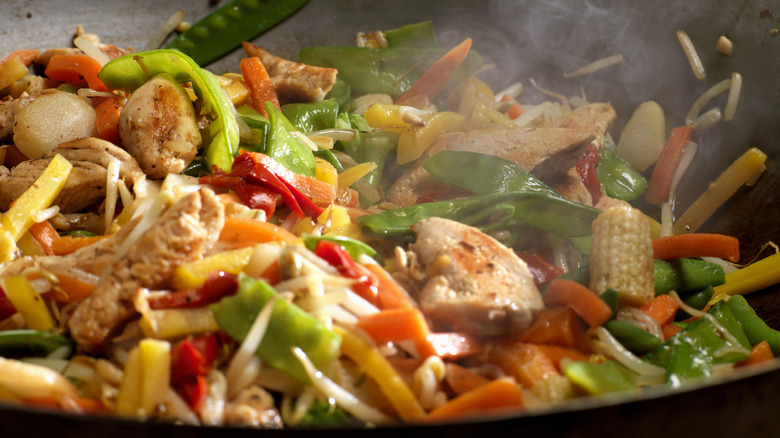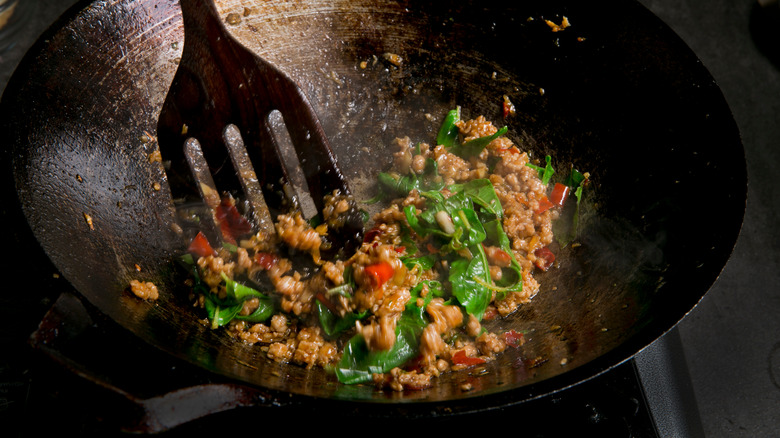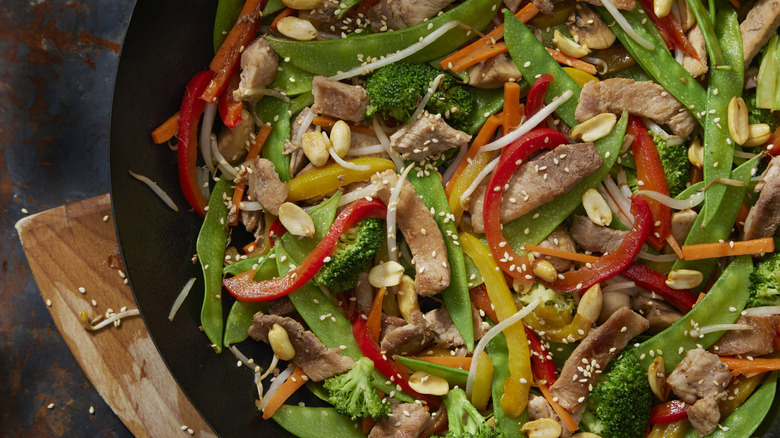Adding Wet Vegetables To Stir-Fry Is A Surefire Way To Get A Soggy Meal
There's no better simple weeknight meal than stir-fry. But in reality this dish isn't always easy to get right. Anyone can make an okay stir-fry, but it takes knowledge and skill to make a great one.
One of the stir-fry mistakes that many home cooks get make is the texture. You might have wondered why your stir-fry ends up soggy or otherwise overly liquidy, even after you've cooked all your meat and vegetables through. The liquid pooling at the bottom of the pan is usually due to one of two problems: adding too many "wet" veggies, which give off excess moisture, or adding too many liquid ingredients (such as soy sauce, sesame oil, etc.) into the mix.
Luckily, there are ways to save a wet stir-fry, so stop short before starting fresh. Reducing the liquid, thickening things up with a binder such as cornstarch or flour, or draining off the liquid are all viable fixes and will help save your final product from becoming stir-fry soup.
Ways to fix a soggy stir-fry
If you're already past the point of no return and your stir-fry resembles a wet mess, don't fret. It's relatively easy to save a liquidy stir-fry, though you'll have to act quickly to save the dish from becoming overcooked mush. If you're using sturdy ingredients that can withstand being cooked down a little longer, you can simmer the liquid in your pan until it thickens up naturally. As the liquid boils, the water will evaporate and cook off, leaving a thicker sauce as a result. But if you've used delicate ingredients, such as shrimp, leafy greens, or vegetables like snow peas, you run the risk of wilting them if you let them simmer for too long.
One alternative is to drain the excess liquid, as you'd drain excess grease from ground beef or other fatty meats. This can help but can sacrifice flavor — you might drain away some of the seasonings you've added as well (such as soy sauce, cooking wine, sesame oil, or other flavor-enhancing additions).
Rather than draining it, you can also thicken your sauce by whisking in a cornstarch slurry. Pour out some of the excess liquid into a bowl or cup, add a few teaspoons of cornstarch, and whisk. Then put the mixture back in the pan and allow it to simmer for a minute or two, until the sauce becomes thick like a gravy.
Get a better stir-fry every time
Though there are plenty of ways to fix a wet stir-fry, the best way to get a satisfying result is to ensure everything is dry and prepared properly from the very start. Drain every ingredient after washing, and pat meats dry with a paper towel. Cut everything into small, equal pieces for even cooking and to help them fry faster.
You'll also want to limit the amount of vegetables you use that give up a lot of water. Zucchini, cucumber, celery, and bell peppers, among plenty of others, have high water content, and that water will cook out and make everything soggy. Wait until the very end to throw these ingredients in; otherwise, you'll end up with a puddle in your pan.
Go easy on the sauces as well; use less that you think you'll need. You can always add a dash more soy sauce or another squirt of sriracha later. With a little practice, you'll have a picture-perfect stir-fry every time.


